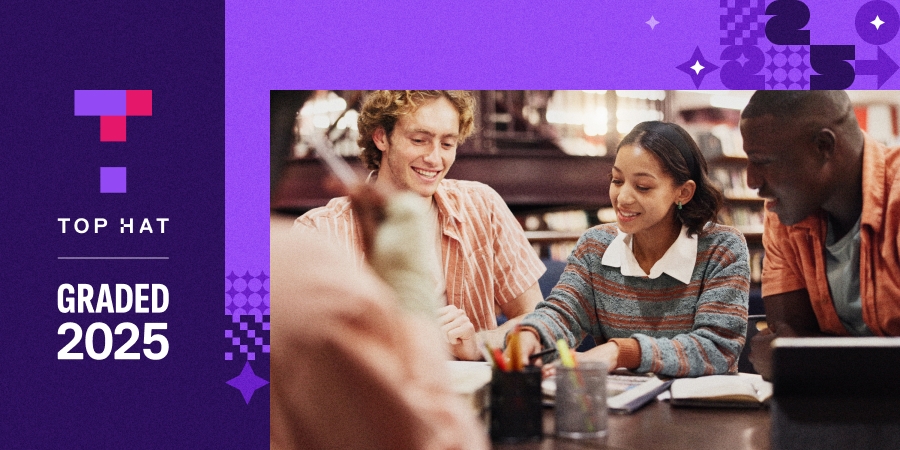One cold December night, I woke up to the sound of a car alarm. It was exam period and about a hundred student finals sat unmarked in my car. Terrified something could happen to them, I got dressed, trekked down the block in the snow and retrieved the papers. The following semester, I went completely paperless. That was two years ago.
I currently use a variety of educational technology (or ed tech) in my communications classes, which have helped completely streamline my teaching. There are many benefits for me and for my students—that said, there are also areas for improvement that aren’t yet addressed with the ed tech I use.
What I love about tech in the college classroom
Increased student collaboration and engagement
This is likely the biggest benefit of ed tech in my classroom. I encourage student participation by using my college email account to display student work on the Smartboard. When responding to case studies in class, they can see the multitude of strategies that their peers used to approach a problem. For students, learning from the successes and mistakes of your peers in real-time is such a valuable tool. It facilitates greater interaction, collaboration and psychological safety. While students often begin my classes apprehensive to share their work with the group, by the end of the class they are eager to share with each other.
Efficient use of time
Thanks to ed tech, I come to campus without bringing any materials with me, because every course I’ve taught has been archived on our learning management system (LMS). And I no longer carry around student work, fearful that it will get lost or damaged.
Environmentally responsible
The paper waste in my classroom was difficult to control. Printing articles, assignments and course outlines was wasteful and inefficient. Extra copies were always left over when students forgot them or didn’t attend class. Now that I’ve gone paperless, there is no waste, with the added benefit of saving on the cost of printing and paper.
Less administrative frustration
Nothing is more frustrating than wasting time with unnecessary administrative work—printing and photocopying being the most frustrating of all. If the printer in our faculty office isn’t working, the photocopier is jammed or it’s too late to send something to printing services, my prep time can double or triple. Using tech replaces the need for printing and photocopying, which saves time and frustration.
Sharing resources between classes
Before class even begins, I’m able to share useful and timely resources with my students. Whether it’s an article or a podcast that is relevant to our class discussion or their program area, sharing these resources with my students creates excellent touch points throughout the course.
Easier student work submission and storage
Marking papers online was a bit of an adjustment, especially in communications courses where the majority of student work involves writing. However, once the rubrics are built, it’s easy to communicate to students where they succeeded and where they can improve. Another huge benefit is being able to meet with students during class time or office hours with all their work at your fingertips. This database of their submissions also replaces the need to store physical exams that typically need to be retained for at least four semesters.
Reliable plagiarism software
The plagiarism software connected to the LMS allows me to review student work with more confidence around academic honesty. The software has directed me to websites where students have freelancers bidding to complete their work and it has also directed me to students resubmitting an assignment that they wrote for another class.
Streamlined organization
Having all your course materials in one place creates an excellent resource for students. Whether they are working on an assignment or studying for a test, they can easily find and use all the materials they need.
Feedback using survey software
Using survey software, my students can provide specific feedback throughout the course, rather than the broader feedback I receive through my college’s Student Feedback Questionnaire. By polling my students throughout the course, I can ask them specific questions to gauge their understanding and opinions of the course and adjust appropriately.
My biggest challenges around tech in the classroom
Difficulties streamlining through one platform
There is a lot of great ed tech available, but I don’t want to confuse my students by using multiple modalities. As a result, I streamline the course through my LMS. However, it is difficult for one system to fulfill all my needs the way multiple ed tech resources could. The LMS is not always intuitive for students and it has limited functionality on their devices. From an instructor perspective, it is only functional on my desktop.
Problems with in-class testing
The submission of tests through the LMS is a great benefit to both students and instructors, but two main difficulties have arisen for me: When not in the testing centre, a student can navigate away from the test itself to view their notes or the Internet. Also, students could write the test from outside the classroom, which makes taking attendance necessary.
Reposting of course materials online
Professors spend a great deal of prep time on their materials. I am thrilled if students can get good use out of them. I am not thrilled when I see students repost my materials online for profit as some websites allow them to do.
Need for “live” documents
Because I don’t want to confuse my students with too many tools, I don’t use Google Docs. However, as my online lists of student groups and student meeting schedules are constantly changing, a living version of these documents on our LMS would be very helpful.
Accessibility of laptop computers
While most students have some sort of smartphone device, to gainfully participate in a communications course, a tablet or laptop computer is needed. This technology may not be accessible for all students depending on the socio-economic diversity of an institution.
Overuse of tech
Students get excited about tech, but it should support student learning and interaction, not replace it. For many student presentations, there has been so much dependence on quizzing software that I have disallowed it from student presentations in favor of more tangible interactions which I model throughout my courses.
Teaching is an iterative process and so is the use of ed tech in my classroom. The landscape is constantly changing and mine is certainly not a perfect system. However, it has been of great benefit for me and my students. And I am optimistic that the opportunities to use tech in the classroom will continue to grow with the development and adoption of new technology.


